

Questions and Answers About Vision Council
Kalamazoo in Transformation
Succeeding with New Economic Rules
Prepared by:
James 0. Gollub
IDeA
Information Design Associates, LLC
with the assistance of
ICF-Kaiser International
Overview
New economic rules and their implications for Kalamazoo
Collaborative strategy process and the lessons of others
The question of what next?
New Economic Rules Create New Challenges
![]() Rule 1: Metropolitan regions generate
prosperity
Rule 1: Metropolitan regions generate
prosperity
- Not political jurisdictions
![]() Rule 2: Regional prosperity arises from
competitive industry clusters
Rule 2: Regional prosperity arises from
competitive industry clusters
- Not individual industries or firms
![]() Rule 3: Cluster competitiveness derives from
regional advantage
Rule 3: Cluster competitiveness derives from
regional advantage
- Not low labor costs or low taxes
![]() Rule 4: Regional advantage is created by
collaboration
Rule 4: Regional advantage is created by
collaboration
- Not community against community
Rule 1 a. Metropolitan Regions As The New Economic Power
Macro factors do not explain subnational economic performance
American metropolitan regions have diverging economic paths
We are in a new era of "regional economic centers"
Metropolitan regions are centers of this convergence
What Are Regions? Powerful Economic Ecologies
Regions are not jurisdictions, such as cities or states
Businesses do not care about political boundaries--only inputs
Regions are the geographic range of commuters
They are the "coral reef" of business relationships
On Facing Change...Kalamazoo in A Regional Context
Kalamazoo s challenges were created long ago...
The city grew around its core industries
Kalamazoo's prosperity is now connected to how well its region performs
How Has Your Region Performed?
Prosperity score based on national index: 40% (on a scale of 100%)
Average wages (1996): $20,458 (US $27,901 1995)
Average annual wage growth, 1975-1996: -0.3% (US 0.02%)
Average annual employment growth, 1975-1996: 0.9% (US 1.9%)
How Much Disparity is There Within This Region?
Income inequality (standard deviation of income distribution), 1990: $32,366
Ave. non-white income as percentage of ave. white income, 1990: 64%
MSA poverty rate, 1990: 13.5%
Ratio of central city to MSA Poverty Rate, 1990: 1.9
Rule 2. Industry Clusters As Sources of Prosperity
![]() What Are Industry Clusters?
What Are Industry Clusters?
- Agglomerations of competing and collaborating industries
- Networked into horizontal and vertical relationships
- With Strong buyer-supplier linkages
- Sharing foundation of specialized economic institutions
- Export oriented, bringing new wealth into a region
Structure of the Electronics Industry Cluster
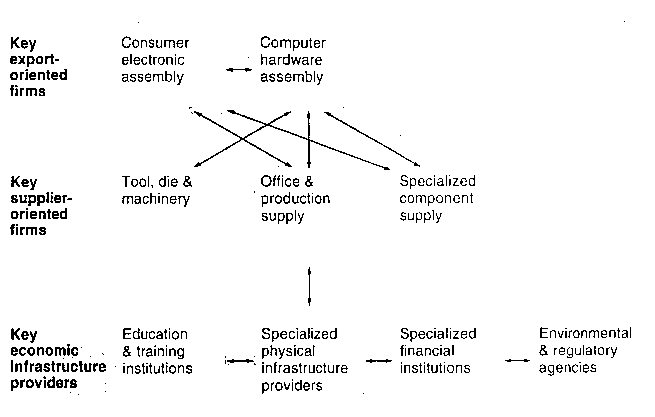
Every Region Has A Distinctive Portfolio of Industry Clusters
• Diversity: Number of distinct clusters present in the region
• Stage of Life Cycle: Emerging, expanding, transforming
• Breath: Number of industries present within each cluster
• Depth: Extent of value-added to final product by suppliers within cluster
Regional Prosperity is Driven by Cluster Competitiveness
32 export-focused industry clusters drive the US economy
Clusters average one-third total employment, but generate the rest
Regions with competitive clusters are most successful
- San Jose, CA MSA
- Austin, TX MSA
Regions with less competitive clusters fare less well
- Pueblo, CO MSA
- Cumberland, MD-WVA MSA
What is the Kalamazoo- Battle Creek Cluster Portfolio?
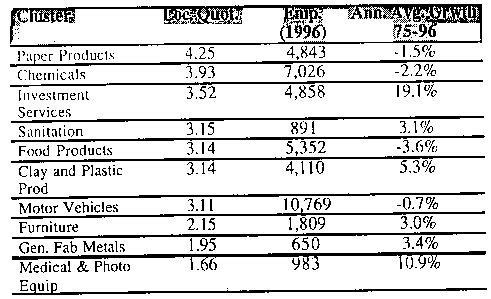
How Does Kalamazoo Fit in This Region?
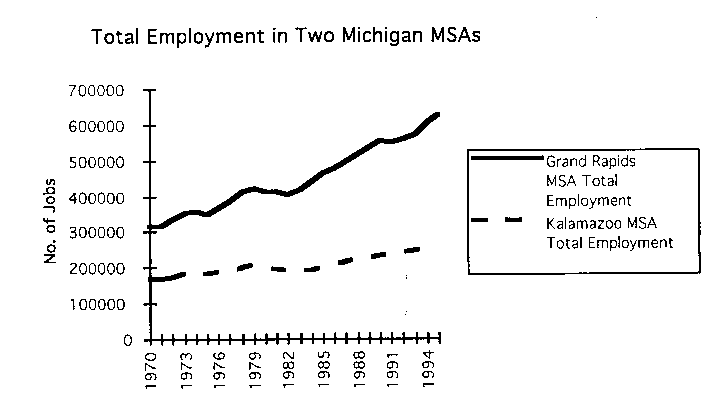
How Does The Region Compare to Grand Rapids on Manufacturing Employment?
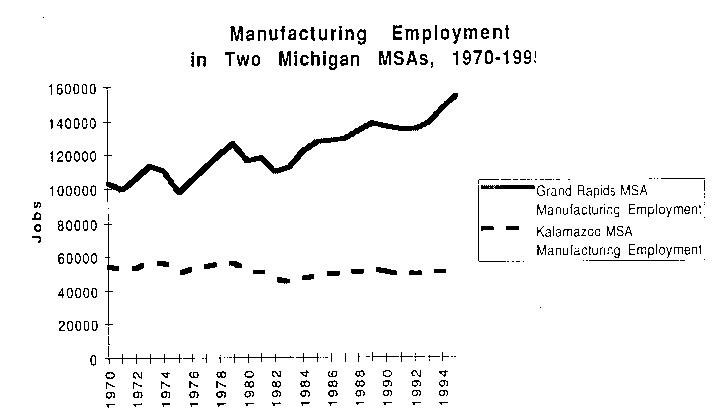
What is the Competitive Position of the Kalamazoo Region's Clusters?
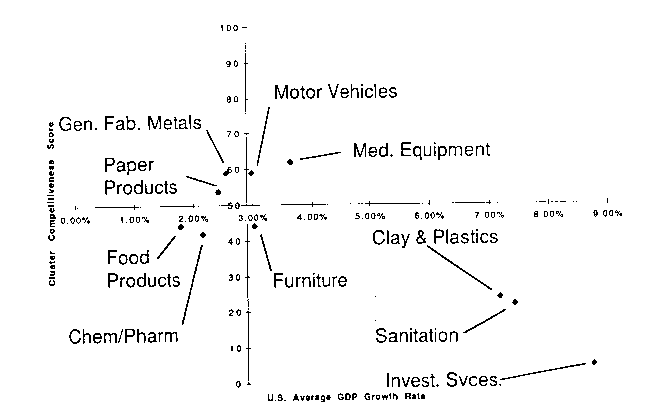
What is the Competitive Position of the Grand Rapids Region's Clusters?
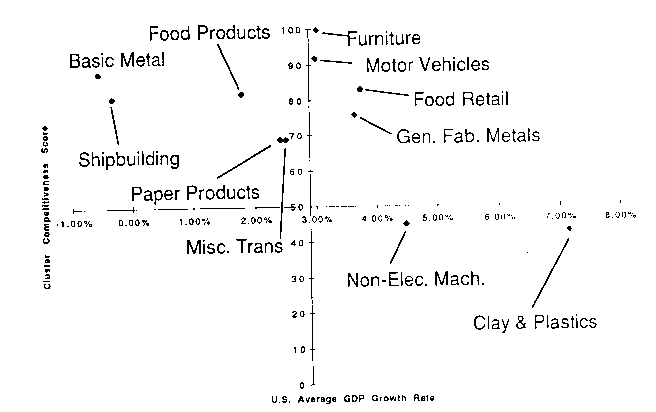
Rule 3: Advantage in Regional Economic Inputs Enables Cluster Competitiveness
Economic infrastructure are sources of economic inputs needed by clusters.
A region can provide seven types of advantage through its institutions:
- Adaptable skills
- Accessible technology
- Adequate financing
- Available infrastructure
- Advanced telecommunications
- Acceptable regulatory and business climate
- Achievable quality of life
Adaptable Skills
Preparation: K-12 graduation levels, entry level skills
Advancement: Colleges, universities all occupational skills concentration
Renewal: Continuing education, retraining, incoming workforce growth
Accessible Technology
Discovery: University and laboratory generated science linkages
Development: Corporate and private labs, linkages to R&D institutions
Deployment: Vendors, suppliers and industrial extension services
Adequate Financing
Initiation: Venture capital networks, seed capital funds, incubators
Expansion: Investment banking corporate investment, commercial loans
Restructuring: Loan guarantees, LBOs and acquisitions
Available Infrastructure
Airports and ports: National and international commercial and freight frequency
Distribution System: Highways, trucking, rail and related delivery service
Power and Environment: Alternative sources of electricity, gas, waste disposal
Acceptable Regulatory and Business Climate
Taxes: Per capita tax levels (relative to benefits received)
Regulation: Number and complexity of permitting requirements
Administration: Responsiveness to business requirements
Achievable Quality of Life
Housing: Average home ownership costs, growth, alternatives
Health and Social Services: Insurance costs, quality of care
Recreation: Diversity and uniqueness of entertainment options
Economic Input Advantage Must Respond to Specific Cluster Needs
Fast growth high value-added industries need advantages in:
- Technology
- Skills
- Quality of life
- Financing
Slower growth, commodity industries need advantages in
- Regulatory and business climate
- Transportation infrastructure
How Does the Kalamazoo-Battle Creek Region Rank on Economic Inputs?
![]() Adaptable Skills:
Adaptable Skills:
- % College graduates: 54 of 299 MSAs
- % Graduate degrees: 33 of 299
![]() Accessible Technology:
Accessible Technology:
- Scientists per 1000 employees: 213 of 299
- Patents per 1000 employees: 109 of 312
- University R&D per 1000 employees: 121 of 315
![]() Adequate Infrastructure (Transportation):
Adequate Infrastructure (Transportation):
- Enplanements per 1000 employees: 154 of 266
- Commute time (min.): 197 of 299
![]() Acceptable Tax and Business Climate (higher
score means higher taxes):
Acceptable Tax and Business Climate (higher
score means higher taxes):
- Taxes as Ratio of Regional Personal Income: 109 of 231
![]() Achievable Quality of Life:
Achievable Quality of Life:
- Housing costs: 164 of 299 (higher score means more expensive)
- Cultural amenities: 130 of 315
- Recreational amenities: 128 of 315
Rule 4: Collaboration Enables Development of Regional Advantage
Regions with successful clusters have responsive economic institutions
Enabled by strong civic leadership and collaboration:
- Across and within public and private sectors
- Across communities in the region
- Between institutions and with customers
With "Collaborative Advantage" regional buyers and suppliers work together.
Proximity and economies of scale improve innovation and access to markets.
Gauging Your Need for Cluster-Based Development
The cluster-based framework is a valuable tool for economic change. It is:
- Market driven: Brings demand and supply side of the economy together.
- Inclusive: Reaches out to firms, suppliers and economic institutions.
- Collaborative: Focuses on collaborative solutions driven by self-interest.
- Strategic: Creates shared commitment to action by many constituencies.
- Value Creating: Improves regional economic depth and breadth.
When is the Cluster Approach Right For Kalamazoo?
The Right Economic Scale: You are thinking regionally, not jurisdictionally.
The Right Economic Challenge: You are responding to the need for improved economic inputs.
The Right Economic Focus: You think about your region's economic portfolio.
The Right Leadership and Process: Your leaders and organizations are ready for an inclusive collaborative process.
The Right Capacity to Take Action: You have a tradition of working regionally with adequate resources and a willingness to work for shared returns.
Cluster-Based Economic Development: A Four-Stage Process

Stage 1: Mobilization--Build interest and participation across constituencies.
Stage 11: Diagnosis--Assess industry clusters and the economic infrastructure that supports cluster performance.
Stage III: Collaborative Strategy-- Convene demand and supply-side stakeholders to identify priority shared challenges and action initiatives.
Stage IV: Implementation--Build commitment of cluster working group participants and regional stakeholders to organize and sustain action.
Primary Lessons Learned from Cluster-Based Experience
• Recruit highly committed leadership.
• Develop a strategy to ensure adequate resources through out the process.
• Choose the right geographic level of focus-regions vs. cities and states.
• Find tools to sustain momentum between stages.
• Engage potential implementing institutions at the earliest stages of the process.
Stage 1: Mobilization Lessons
Use economic challenges as an opportunity to bring stakeholders together.
Kick-start mobilization by creating an organization dedicated to initiative goals.
Cultivate broad public and private sector participation and early "buy-in"
Cultivate stakeholders and "champions"
Where is Kalamazoo With Respect to Mobilization?
Pharmacia-UpJohn merger served as a catalytic event three years ago
- Prior to that local economic issues emphasized urban redevelopment
- Regional issues emphasized disputes between communities
In 1997 the Kalamazoo Rotary Club Convened "The Future of Kalamazoo"
- Initial situation analysis by UpJohn Institute
- Local leaders began to wrestle with need for shared vision
- First steps towards building new models for collaboration started
Stage II: Diagnostic Lessons
Provide an independent analyst who can "tell it like it is".
Use cluster analytic techniques to:
- Identify regional cluster portfolio
- Benchmark regional cluster position.
- Benchmark regional economic infrastructure.
- Assess strategic challenges and opportunities.
Build momentum for the initiative through a participatory diagnostic process.
Metropolitan Austin's Industry Clusters
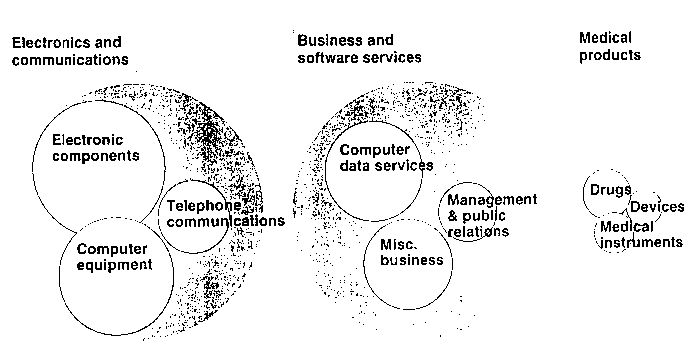
The SELAC Story
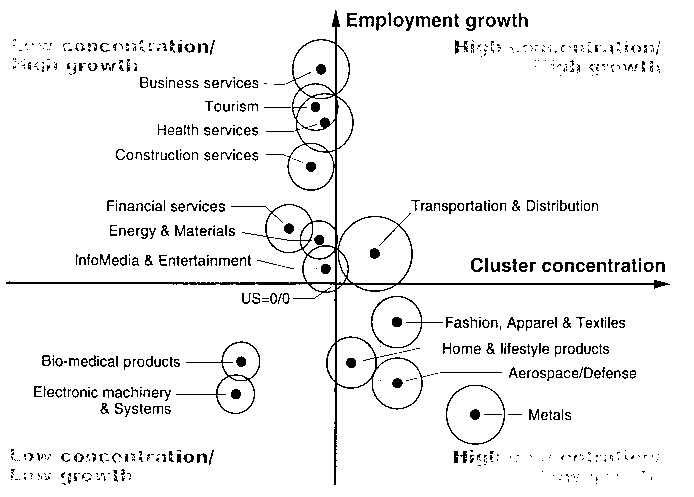
Where is Kalamazoo With Respect to Diagnosis?
Strong interest in changing structure of local and regional economy
Initial cluster overview done (provided in this presentation)
Need to understand changing regional interdependencies
"Portfolio" approach to regional development needed
Stage III: Collaborative Strategy Lessons
Hold events to confront and engage participants from industry and institutions.
Create highly inclusive cluster working groups that are market driven.
Select working group leaders who are committed and can recruit participants.
Create accountability mechanisms and progress milestones during the process.
Develop concrete action plans focusing on reform and redesign, adding value.
Establish the market viability of each initiative to ensure needed support.
Where is Kalamazoo With Respect to Collaborative Strategy?
Region, County and communities not in structured collaborative process yet
Cross-region industry cluster working groups not utilized
Regions, such as Grand Rapids, have used similar process for over 10 years
Region needs to create advantage to form, expand and attract cluster industries
Stage IV: Implementation Lessons
Create a stewardship group by identifying an organization to oversee initiatives.
Use the cluster framework to facilitate supply and demand side connections.
Identify sources for funding commensurate with needs of action initiatives.
Sustain sources of leadership.
Develop a monitoring system to track activities and communicate outcomes.
Lessons from Other Regions: An Integrative Approach to a Market Dialogue
Link education providers with workforce managers.
Connect technology providers with product developers.
Match financial investors to new or existing enterprises.
Shape physical infrastructure to meet industry operational needs.
Invest in information infrastructure to enhance cluster performance.
Adjust administrative systems to maximize cluster productivity.
Bring housing, health and social service providers together with clusters.
Conclusion: Kalamazoo Must Find Common Ground with its Region
![]() Point 1: Kalamazoo needs to think regionally
to compete globally.
Point 1: Kalamazoo needs to think regionally
to compete globally.
- Think of the region as a dynamic "economic ecology".
![]() Point 2: The region's cluster portfolio is at
risk compared to competitors.
Point 2: The region's cluster portfolio is at
risk compared to competitors.
- Harness industry assets to add more value in clusters and grow others.
![]() Point 3: Regional institutions should act
together in support of each cluster.
Point 3: Regional institutions should act
together in support of each cluster.
- Public and private institutions should identify their competencies and better match them to existing and emerging cluster needs.
![]() Point 4: A new culture of collaboration is
essential--Convene the marketplace.
Point 4: A new culture of collaboration is
essential--Convene the marketplace.
- The history of fragmentation must be overcome: Who will be your process "Stewards"?